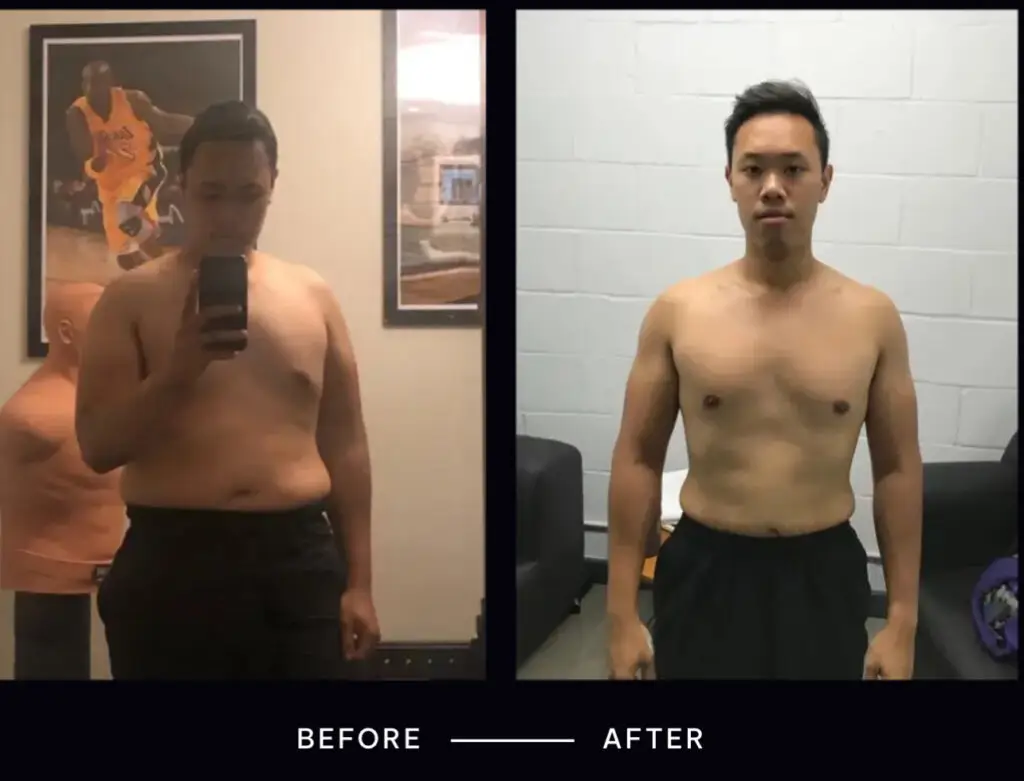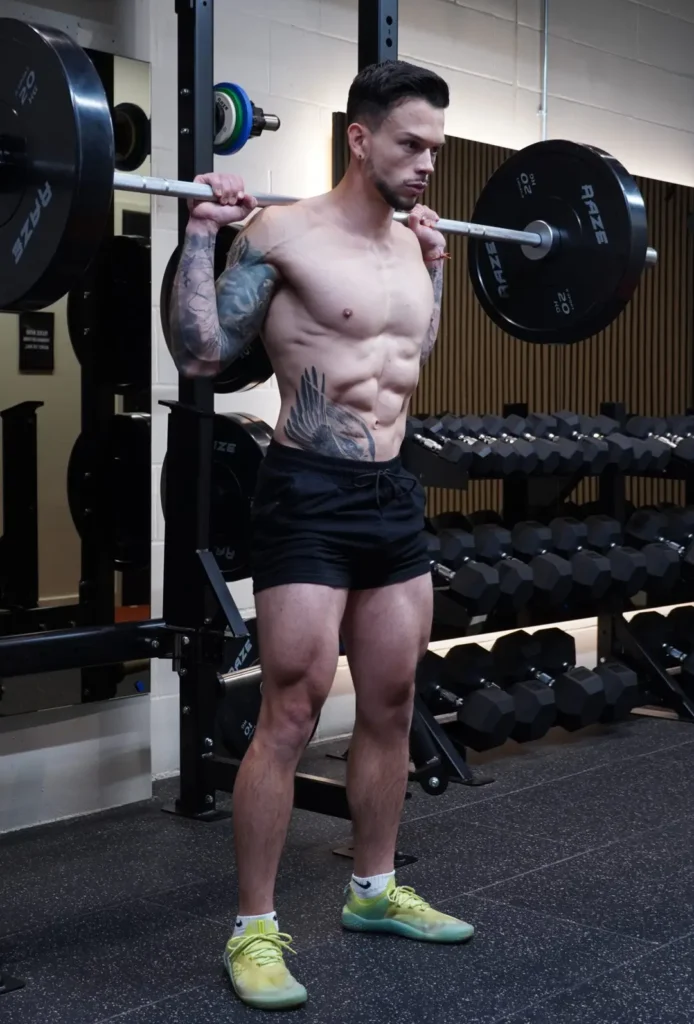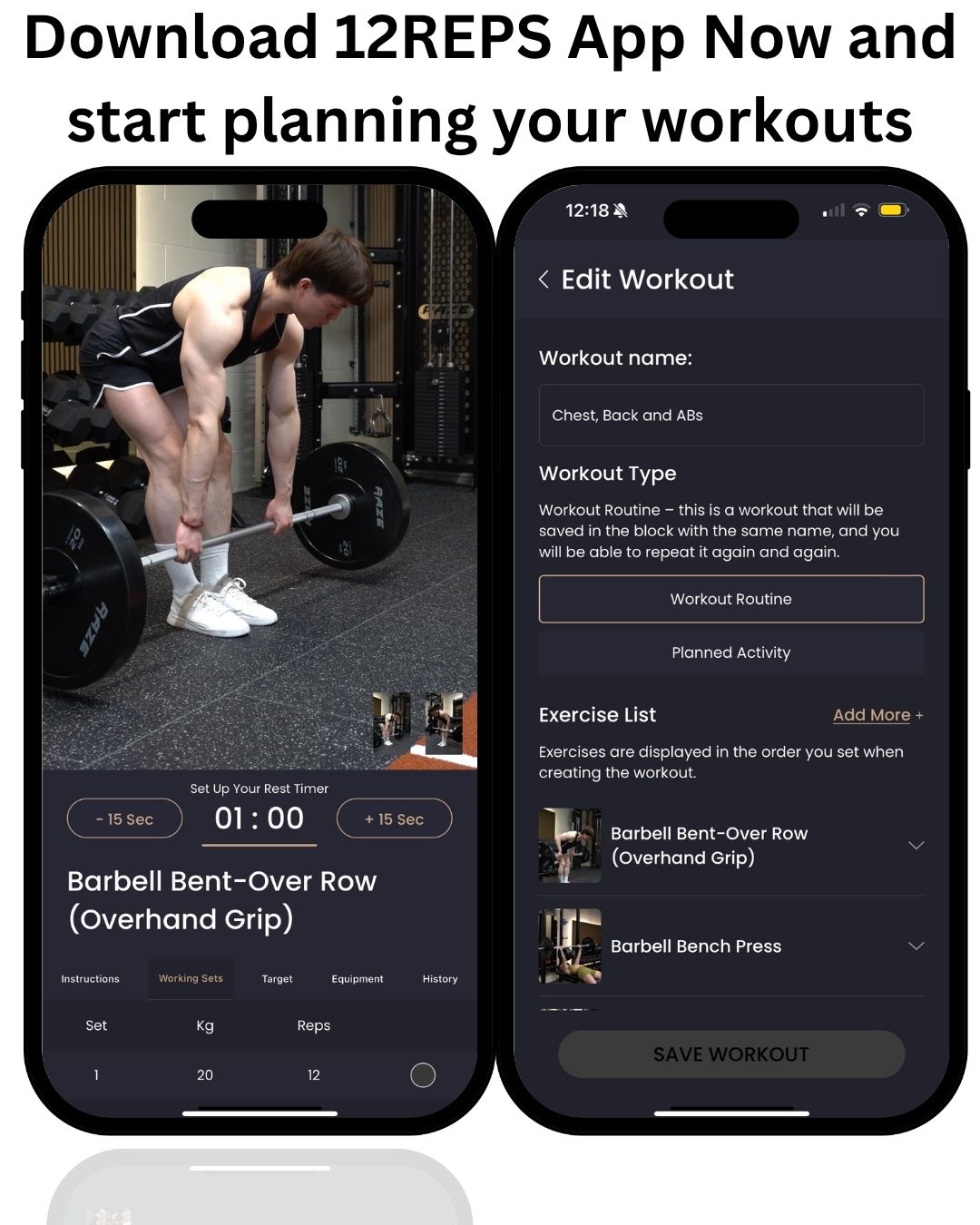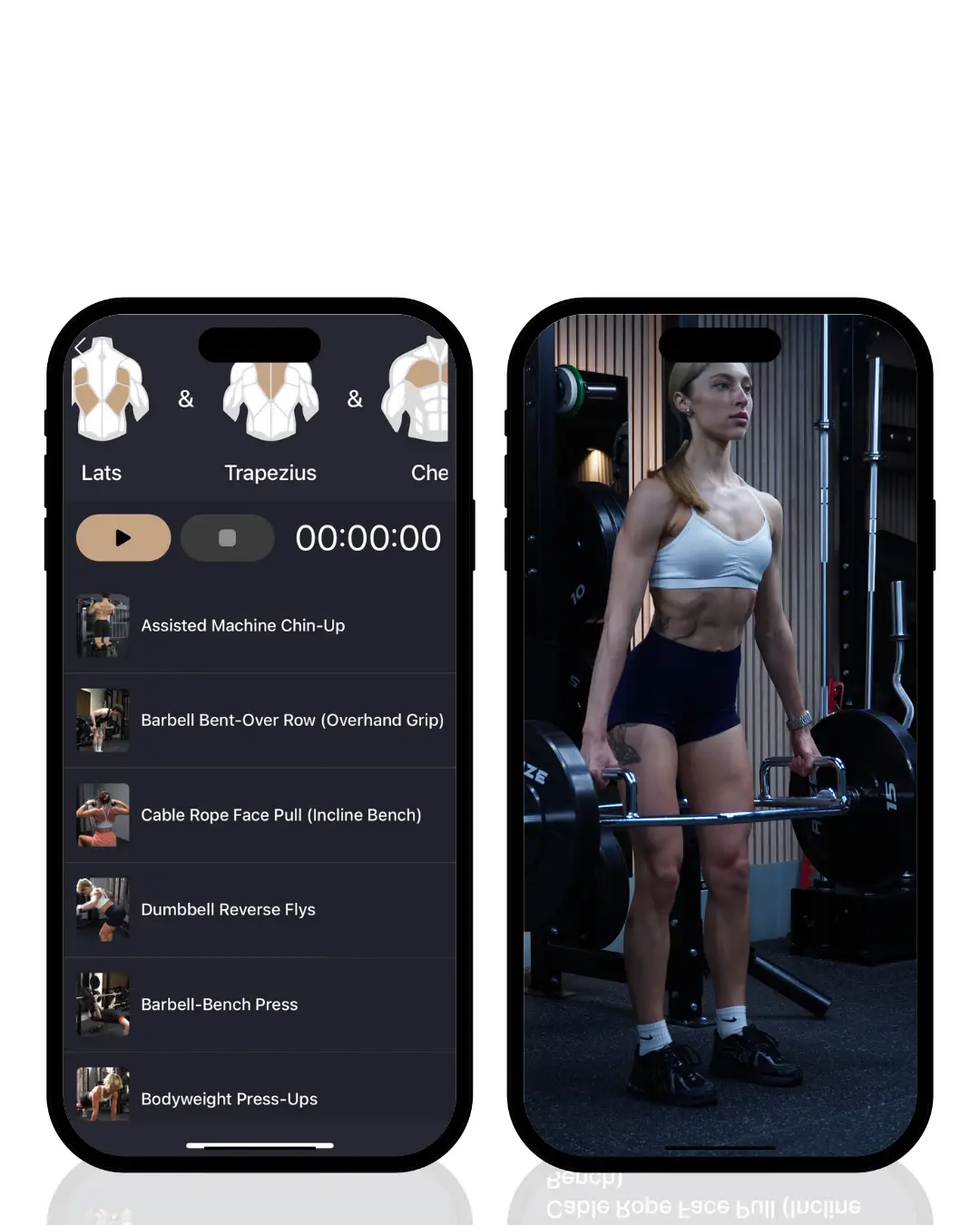Written by Will Duru, BSc (Hons) Sport and Exercise Science, award-winning Personal Trainer with over 10 years of experience in strength training and optimising recovery .
In my 10 years as a personal trainer, I have witnessed countless transformations. But two clients stand out as perfect examples of how strength training improves body composition through pure science. Ola lost 25kg in 7 months, and Jeremy dropped 20kg in 6 months. Both achieved these results not through crash diets or endless cardio, but through understanding and applying the science of strength training.
Most people think weight loss is simple: eat less, move more. This outdated approach ignores the complex science of body composition. Your body composition – the ratio of muscle to fat – determines how you look, feel, and perform. It affects your metabolism, health markers, and confidence levels.
When Ola first came to me, he weighed 125kg and was borderline type 2 diabetic. Doctors warned him about his health risks. Jeremy started at 95kg with low energy and poor self-confidence. Both men tried traditional weight loss methods before. They counted calories, did hours of cardio, and followed restrictive diets. Nothing worked long-term.
The breakthrough came when we shifted focus from weight loss to body composition improvement. Instead of just burning calories, we built muscle while losing fat. This approach transformed not just their bodies, but their entire lives. Ola now competes in boxing matches and runs half marathons. Jeremy was promoted at work and feels more confident than ever.
The science behind these transformations is fascinating. Strength training triggers multiple physiological processes that improve body composition more effectively than any other exercise method. It builds lean muscle mass, increases metabolic rate, improves insulin sensitivity, and creates hormonal changes that favour fat loss.
This article will explain exactly how strength training improves body composition through scientific mechanisms. You will understand why Ola and Jeremy succeeded where other methods failed. More importantly, you will learn how to apply this science to your own transformation.
The 12reps app makes this science accessible to everyone. It creates personalised strength training programs based on your available equipment and goals. Instead of guessing what exercises to do, you get scientifically designed workouts that maximise body composition improvements. Download 12reps app to start your transformation today.

Understanding Body Composition: Beyond Weight Loss
Body composition refers to the proportion of fat mass and lean mass in your body. Lean mass includes muscle, bone, organs, and water. Fat mass is stored body fat. Your body composition determines how you look and feel far more than your total weight.
Two people can weigh exactly the same but look completely different. One person might have high muscle mass and low body fat, appearing lean and athletic. Another might have low muscle mass and high body fat, appearing soft and out of shape. The scale shows the same number, but their body compositions are vastly different.
This is why Ola’s transformation was so dramatic. He lost 25kg of fat while gaining significant muscle mass. His total weight loss was impressive, but the body composition change was life-changing. He went from soft and unhealthy to lean and athletic. His waist size dropped from 42 inches to 34 inches, even though muscle gain reduced his total weight loss.
Jeremy’s story illustrates this principle perfectly. In his first three months, he only lost 8kg on the scale. He felt discouraged until we measured his body composition. He had actually lost 12kg of fat while gaining 4kg of muscle. His body was transforming rapidly, but the scale did not reflect the true changes.
Traditional weight loss approaches focus only on the scale number. They create calorie deficits through diet restriction and cardio exercise. This approach does cause weight loss, but much of that weight comes from muscle tissue. Losing muscle mass slows your metabolism and makes you look soft and weak.
The muscle loss problem explains why most diets fail long-term. When you lose muscle, your metabolic rate drops. You need fewer calories to maintain your weight. Eventually, you return to normal eating habits, but now your metabolism is slower. You regain weight faster than you lost it, often ending up heavier than when you started.
Strength training solves this problem by preserving and building muscle mass during fat loss. When Ola and Jeremy created calorie deficits for fat loss, strength training protected their muscle tissue. They lost fat while maintaining or even gaining muscle. This kept their metabolisms high and created the lean, athletic look they wanted.
The 12reps app tracks your body composition progress, not just weight loss. It helps you understand the difference between fat loss and muscle gain. The app’s progress photos and measurements show real changes that the scale might miss. This keeps you motivated when the scale plateaus but your body continues improving.

The Science of Muscle Building Through Strength Training
Muscle protein synthesis is the foundation of how strength training improves body composition. When you lift weights, you create microscopic damage to muscle fibers. Your body responds by rebuilding these fibers stronger and larger than before. This process requires energy and building materials, both of which come from your diet and stored body fat.
The muscle-building process begins during your workout. Strength training sends signals to your muscle cells to start producing new proteins. These proteins become the building blocks for bigger, stronger muscle fibers. The signalling process continues for 24-48 hours after your workout, which is why rest days are crucial for muscle growth.
Ola’s muscle-building journey perfectly demonstrates this science. When he started training, he could barely do a push-up. His muscle protein synthesis was low because he had never challenged his muscles with resistance. As we progressively increased the weights and intensity, his body adapted by building new muscle tissue.
The key to muscle protein synthesis is progressive overload. You must gradually increase the demands on your muscles over time. This can mean lifting heavier weights, doing more repetitions, or increasing training volume. Without progressive overload, your muscles have no reason to grow larger or stronger.
Hormonal responses to strength training also drive muscle growth. Resistance exercise increases the production of growth hormone, testosterone, and insulin-like growth factor. These hormones create an anabolic environment that favours muscle building and fat loss. The hormonal response is strongest with compound exercises that work multiple muscle groups.
Jeremy experienced dramatic hormonal improvements through strength training. His energy levels increased, sleep quality improved, and mood became more stable. These changes reflected the positive hormonal adaptations from consistent resistance training. The hormonal benefits extended far beyond muscle building to improve his overall quality of life.
The 12reps app includes nutrition guidance to support muscle protein synthesis. It calculates your protein needs based on your body weight and training goals. The app also provides meal timing recommendations to maximise the muscle-building response to your workouts. This scientific approach ensures your nutrition supports your body composition goals.

How Strength Training Affects Fat Loss
Strength training burns calories during exercise, but the fat loss benefits extend far beyond the workout itself. The direct caloric expenditure during resistance training is moderate compared to cardio, but strength training creates metabolic changes that promote fat loss for hours and days after your session ends.
EPOC, or Excess Post-Exercise Oxygen Consumption, is where strength training really shines for fat loss. After intense resistance training, your body continues burning calories at an elevated rate for 12-24 hours. This “afterburn effect” can add 50-200 extra calories burned per day, significantly boosting total fat loss over time.
Jeremy experienced this afterburn effect dramatically. He noticed feeling warm and energised for hours after our training sessions. His appetite was suppressed, and he slept better on training days. These were all signs that his metabolism was elevated from the strength training stimulus.
The increase in metabolic rate from muscle mass is the most powerful fat loss benefit of strength training. Each kilogram of muscle tissue burns approximately 13 calories per day at rest. This might seem small, but it adds up significantly over time. If you gain 5kg of muscle, you burn an extra 65 calories per day without any additional activity.
Ola gained approximately 8kg of muscle during his transformation. This muscle mass increased his daily calorie burn by over 100 calories. Over a year, this equals 36,500 extra calories burned, or about 5kg of fat loss from muscle gain alone. This explains why his fat loss accelerated as he built more muscle.
Improvements in insulin sensitivity from strength training also promote fat loss. Muscle tissue is the primary site for glucose uptake in the body. When you build muscle and train regularly, your muscles become more efficient at using carbohydrates for energy instead of storing them as fat.
The 12-reps app maximises these fat loss benefits by designing workouts that trigger EPOC and build muscle simultaneously. The app’s programs emphasise compound exercises and progressive overload to create the strongest metabolic response. This scientific approach ensures every workout contributes to long-term fat loss success.

Strength Training vs. Other Exercise Modalities
Cardiovascular exercise has dominated fitness recommendations for decades, but research shows strength training is superior for improving body composition. Cardio burns calories during exercise but provides a minimal afterburn effect and does not build muscle mass. This makes it less effective for long-term fat loss and improving body composition.
A landmark study compared cardio-only, strength-only, and combined training groups over 12 weeks. The cardio group lost weight but much of it came from muscle tissue. The strength group lost fat while gaining muscle, achieving better body composition improvements. The combined group had the best results, but strength training was the key component.
Ola tried cardio-only approaches before working with me. He would run for hours each week but saw minimal changes in his body composition. His weight fluctuated, but he never achieved the lean, muscular look he wanted. The cardio was burning calories but not creating the metabolic adaptations needed for lasting change.
Combined training approaches that include both strength and cardio can be effective when programmed correctly. The key is prioritising strength training and using cardio to supplement fat loss. Too much cardio can interfere with muscle building and recovery from strength training.
Research on optimal exercise combinations shows that 3-4 strength sessions plus 1-2 cardio sessions per week produces the best body composition results. This ratio allows adequate stimulus for muscle growth while adding cardiovascular benefits. Strength training must be the foundation of the program.
The 12-reps app recognises the superiority of strength training for body composition goals. While the app includes some cardio options, the focus is on progressive resistance training. The app’s algorithms prioritise exercises and programs that build muscle and improve metabolic rate for lasting results.
Factors Affecting Body Composition Changes
Individual variation in response to strength training is significant and depends on multiple factors. Genetics play a role in muscle building potential, fat loss rate, and body fat distribution patterns. However, everyone can improve their body composition through consistent strength training, regardless of their genetic starting point.
Ola and Jeremy had different genetic advantages and challenges. Ola was naturally strong but carried excess body fat easily. Jeremy was naturally lean but struggled to build muscle mass. Both achieved excellent results by working with their genetic tendencies rather than against them.
Nutrition plays a crucial role in body composition changes from strength training. You cannot out-train a poor diet, but you also cannot achieve optimal results through diet alone. The combination of proper nutrition and strength training creates synergistic effects that maximise body composition improvement.
Both Ola and Jeremy followed structured nutrition plans that supported their training goals. They ate adequate protein to support muscle building and created moderate calorie deficits to promote fat loss. The nutrition plan was as important as the training program for their success.
Timeline expectations for body composition changes help maintain motivation during the process. Strength gains occur within weeks, but visible muscle growth takes 6-8 weeks. Significant body composition changes typically require 3-6 months of consistent training and nutrition.
Ola saw his first major changes around month 3, when people started commenting on his appearance. Jeremy’s transformation became obvious around month 4. Both continued improving for over a year, showing that body composition change is a long-term process.
The 12-reps app accounts for individual variation by personalising programs based on your experience level, available equipment, and goals. The app adjusts training variables as you progress, ensuring continued adaptation and improvement. This individualised approach maximises results for your specific situation.
Practical Applications: Maximising Body Composition Benefits
Programming for body recomposition requires balancing muscle-building and fat-loss goals. This means creating a moderate calorie deficit while providing adequate stimulus for muscle growth. The training program must emphasise progressive overload while allowing sufficient recovery.
The most effective approach combines compound exercises with isolation movements. Compound exercises like squats, deadlifts, and presses work multiple muscle groups and create the strongest muscle-building and metabolic response. Isolation exercises target specific muscles and help address imbalances.
Ola’s program emphasised compound movements initially to build overall strength and muscle mass. As he progressed, we added isolation exercises to target specific areas and improve muscle definition. This progression from general to specific training optimised his body composition changes.
Nutrition strategies to support body recomposition focus on adequate protein intake and moderate calorie deficits. Protein should be 1.6-2.2g per kg of body weight to support muscle protein synthesis. The calorie deficit should be 300-500 calories per day to promote fat loss without compromising muscle building.
Monitoring progress beyond the scale is essential for body recomposition goals. Body measurements, progress photos, and strength gains provide better indicators of success than weight alone. The scale can be misleading when you are building muscle and losing fat simultaneously.
The 12-reps app provides comprehensive guidance for maximising body composition benefits. It creates periodized programs that balance muscle-building and fat-loss goals. The app tracks multiple progress metrics beyond weight and adjusts your program as you advance. This scientific approach ensures continued improvement toward your body composition goals.
6-Week Body Recomposition Program
This comprehensive program uses multiple equipment types to maximise body composition improvements. It follows the same scientific principles that helped Ola and Jeremy achieve their transformations. The program progresses from foundation building to advanced strength and power development.
Week 1: Foundation Building – Bodyweight + Light Equipment
Day 1: Push (Chest, Shoulders, Triceps)
Exercise A | Sets | Reps | Rest | Exercise B (Superset) | Sets | Reps | Rest |
Push-ups | 3 | 8-12 | 30s | Resistance Band Chest Press | 3 | 12-15 | 60s |
Pike Push-ups | 3 | 5-8 | 30s | Dumbbell Shoulder Press (light) | 3 | 10-12 | 60s |
Tricep Dips | 3 | 6-10 | 30s | Kettlebell Overhead Hold | 3 | 20-30s | 60s |
Day 2: Pull (Back, Biceps)
Exercise A | Sets | Reps | Rest | Exercise B (Superset) | Sets | Reps | Rest |
Inverted Rows | 3 | 5-8 | 30s | Resistance Band Rows | 3 | 12-15 | 60s |
Superman Hold | 3 | 15-20s | 30s | Dumbbell Bent-over Row (light) | 3 | 10-12 | 60s |
Reverse Fly (bodyweight) | 3 | 10-15 | 30s | Kettlebell High Pull | 3 | 8-10 | 60s |
Day 3: Legs (Quads, Glutes, Hamstrings)
Exercise A | Sets | Reps | Rest | Exercise B (Superset) | Sets | Reps | Rest |
Bodyweight Squats | 3 | 15-20 | 30s | Kettlebell Goblet Squat | 3 | 10-15 | 60s |
Lunges | 3 | 8 each | 30s | Resistance Band Squats | 3 | 12-15 | 60s |
Glute Bridges | 3 | 15-20 | 30s | Dumbbell Romanian Deadlift (light) | 3 | 10-12 | 60s |
Weeks 2-3: Strength Building - Multi-Equipment Supersets
Day 1: Push (Chest, Shoulders, Triceps)
Exercise A | Sets | Reps | Rest | Exercise B (Superset) | Sets | Reps | Rest |
Dumbbell Bench Press | 4 | 8-12 | 30s | Push-ups | 4 | 8-12 | 90s |
Barbell Overhead Press | 4 | 6-10 | 30s | Resistance Band Lateral Raises | 4 | 12-15 | 90s |
Machine Chest Press | 4 | 10-12 | 30s | Kettlebell Press | 4 | 8-10 each | 90s |
Day 2: Pull (Back, Biceps)
Exercise A | Sets | Reps | Rest | Exercise B (Superset) | Sets | Reps | Rest |
Barbell Bent-over Row | 4 | 8-12 | 30s | Resistance Band Face Pulls | 4 | 15-20 | 90s |
Machine Lat Pulldown | 4 | 10-12 | 30s | Dumbbell Bicep Curls | 4 | 10-15 | 90s |
Kettlebell Single-arm Row | 4 | 8-10 each | 30s | Inverted Rows | 4 | 6-10 | 90s |
Day 3: Legs (Quads, Glutes, Hamstrings)
Exercise A | Sets | Reps | Rest | Exercise B (Superset) | Sets | Reps | Rest |
Barbell Back Squat | 4 | 8-12 | 30s | Kettlebell Swings | 4 | 15-20 | 90s |
Machine Leg Press | 4 | 12-15 | 30s | Dumbbell Lunges | 4 | 10 each | 90s |
Dumbbell Romanian Deadlift | 4 | 10-12 | 30s | Resistance Band Glute Bridges | 4 | 15-20 | 90s |
Weeks 4-6: Power and Strength Development - Advanced Training
Day 1: Push (Chest, Shoulders, Triceps)
Exercise A | Sets | Reps | Rest | Exercise B (Superset) | Sets | Reps | Rest |
Barbell Bench Press | 5 | 6-8 | 30s | Kettlebell Push Press | 5 | 8-10 each | 90s |
Dumbbell Incline Press | 5 | 8-12 | 30s | Resistance Band Chest Fly | 5 | 12-15 | 90s |
Machine Shoulder Press | 4 | 10-15 | 30s | Dumbbell Lateral Raises | 4 | 12-15 | 90s |
Barbell Close-grip Bench | 4 | 8-12 | 30s | Kettlebell Bottoms-up Press | 4 | 5-8 each | 90s |
Day 2: Pull (Back, Biceps)
Exercise A | Sets | Reps | Rest | Exercise B (Superset) | Sets | Reps | Rest |
Barbell Deadlift | 5 | 5-8 | 30s | Kettlebell High Pull | 5 | 8-12 | 90s |
Machine Cable Row | 5 | 10-15 | 30s | Dumbbell Hammer Curls | 5 | 10-15 | 90s |
Dumbbell Single-arm Row | 4 | 8-12 each | 30s | Resistance Band Reverse Fly | 4 | 15-20 | 90s |
Machine Lat Pulldown | 4 | 12-15 | 30s | Kettlebell Upright Row | 4 | 10-12 | 90s |
Day 3: Legs (Quads, Glutes, Hamstrings)
Exercise A | Sets | Reps | Rest | Exercise B (Superset) | Sets | Reps | Rest |
Barbell Front Squat | 5 | 6-10 | 30s | Kettlebell Goblet Squats | 5 | 12-15 | 90s |
Machine Leg Press | 5 | 12-18 | 30s | Dumbbell Step-ups | 5 | 8 each | 90s |
Barbell Romanian Deadlift | 4 | 8-12 | 30s | Resistance Band Lateral Walks | 4 | 12 each | 90s |
Machine Leg Curl | 4 | 12-15 | 30s | Kettlebell Single-leg Deadlift | 4 | 6-8 each | 90s |
Program Notes
- Rest 1 day between each training session
• Progress by adding weight, then reps, then sets
• Focus on proper form over heavy weight
• Complete Exercise A, rest 30 seconds, then complete Exercise B, rest 90 seconds before repeating
• Use the 12reps app to track your progress and log workouts
• Adjust weights based on your strength level and available equipmentEquipment Substitutions:
• No barbell? Use dumbbells or kettlebells for similar movements
• No machines? Replace with resistance band or free weight alternatives
• Limited equipment? The 12reps app adapts any program to your available equipmentDownload the 12reps app at just12reps.com to access:
• Personalised programs based on your available equipment
• Automatic progression tracking and weight recommendations
• Video demonstrations of every exercise
• Body composition tracking tools
• Nutrition guidance to support your transformation
• Progress photos and measurement tracking

Conclusion
The science is clear: strength training improves body composition more effectively than any other exercise method. Through muscle protein synthesis, metabolic adaptations, and hormonal changes, resistance training builds muscle while promoting fat loss. This creates the lean, athletic physique that most people desire.
Ola and Jeremy’s transformations demonstrate the power of applying this science consistently. Both men achieved dramatic body composition improvements by focusing on progressive strength training supported by proper nutrition. Their results were not due to genetics or luck, but to understanding and applying proven scientific principles.
The key to success is consistency and progression. You must challenge your muscles with gradually increasing demands over time. This progressive overload triggers the adaptations that improve body composition. Combined with adequate protein intake and moderate calorie deficits, strength training creates sustainable, long-term results.
Body composition improvement is a marathon, not a sprint. Expect to see strength gains within weeks, but significant visual changes take months. The process requires patience and persistence, but the results are worth the effort. Unlike quick-fix approaches, strength training creates lasting changes that improve with time.
Your transformation starts with the first workout. Every training session triggers muscle protein synthesis and metabolic adaptations that improve your body composition. The cumulative effect of consistent training creates dramatic changes over months and years.
The 12reps app makes this science accessible to everyone, regardless of experience level or available equipment. It removes the guesswork from program design and ensures you are following scientifically proven methods. The app tracks your progress and adjusts your program as you advance, maximising your results.
Download the 12reps app at just12reps.com and start your body composition transformation today. Join thousands of users who have achieved their goals through science-based strength training. Your stronger, leaner, more confident self is waiting.

References
- Westcott, W.L. (2012). Resistance training is medicine: effects of strength training on health. Current Sports Medicine Reports, 11(4), 209-216.
2. Strasser, B., & Schobersberger, W. (2011). Evidence for resistance training as a treatment therapy in obesity. Journal of Obesity, 2011, 482564.
3. Donnelly, J.E., et al. (2009). American College of Sports Medicine Position Stand. Appropriate physical activity intervention strategies for weight loss and prevention of weight regain for adults. Medicine & Science in Sports & Exercise, 41(2), 459-471.










